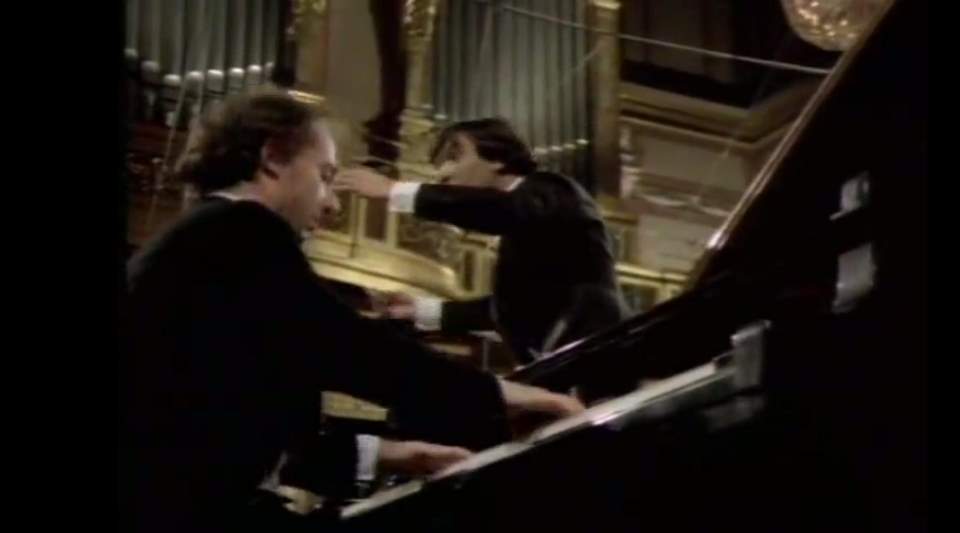Accompanied by the Staatskapelle Dresden, Italian classical pianist Maurizio Pollini performs Johannes Brahms’ Piano Concerto No. 1 in D minor, Op. 15. Conductor: Christian Thielemann. Recorded at Semperoper, Dresden in June 2011.
The Staatskapelle Dresden is an orchestra based in Dresden, Germany founded in 1548 by Kurfürst Moritz of Saxony. It is one of the world’s oldest orchestras. The precursor ensemble was Die Kurfürstlich-Sächsische und Königlich-Polnische Kapelle.
The Semperoper is the opera house of the Sächsische Staatsoper Dresden and the concert hall of the Sächsische Staatskapelle Dresden. It is also home to the Semperoper ballet.
Brahms’ Piano Concerto No. 1

Movements
Maurizio Pollini
Maurizio Pollini (5 January 1942 – 23 March 2024) was born in Milan to the Italian rationalist architect Gino Pollini, who is said to have been the first to bring Modernist architecture to Italy in the 1930s.
Pollini studied piano first with Carlo Lonati, until the age of 13, then with Carlo Vidusso, until he was 18. He received a diploma from the Milan Conservatory and won both the International Ettore Pozzoli Piano Competition in Seregno (Italy) in 1959 and the International Chopin Piano Competition in Warsaw in 1960.
Arthur Rubinstein, who led the jury, declared Pollini the winner of the competition, allegedly saying: “That boy can play the piano better than any of us”.

Soon afterward, for EMI he recorded Chopin’s Concerto No. 1 in E minor with the Philharmonia Orchestra under the Polish conductor Paul Kletzki and taped performances of Chopin’s etudes. When Philharmonia offered Pollini a series of concerts, he experienced what EMI producer Peter Andry has called “an apparent crisis of confidence”.
After this, he studied with Arturo Benedetti Michelangeli, from whom he is said to have acquired “a precise technique and emotional restraint”, although some have expressed a concern that Michelangeli’s influence resulted in Pollini’s playing becoming “mannered and cold”. During the early 1960s, Pollini limited his concertizing, preferring to spend these years studying by himself and expanding his repertoire.
Since the mid-1960s, he has given recitals and appeared with major orchestras in Europe, the United States, and the Far East. He made his American debut in 1968 and his first tour of Japan in 1974.
During the 1960s and 1970s, Pollini was a left-wing political activist. He collaborated with Luigi Nono in such works as Como una ola fuerza y luz (1972), which was to mourn the assassination of Luciano Cruz, a leader of the Chilean Revolutionary Front. He performed with Claudio Abbado at La Scala in a cycle of concerts for students and workers, in an attempt to build a new public as they believed that art should be for everybody.
In 1985, on the occasion of Johann Sebastian Bach’s tricentenary, he performed the complete first book of The Well-Tempered Clavier. In 1987 he played the complete piano concertos of Ludwig van Beethoven in New York with the Vienna Philharmonic under Claudio Abbado and received on occasion the orchestra’s Honorary Ring.
In 1993-94 he played his first complete Beethoven Piano Sonata cycles in Berlin and Munich and later also in New York, Milan, Paris, London, and Vienna. At the Salzburg Festival in 1995, he inaugurated the “Progetto Pollini”, a series of concerts in which old and new works are juxtaposed. An analogous series took place at Carnegie Hall in 2000-01 with “Perspectives: Maurizio Pollini” and at London’s Royal Festival Hall in 2010-11 with the “Pollini Project”, a series of five concerts with programs ranging from Bach to Stockhausen.
In March 2012 it was announced that Pollini had canceled all his forthcoming appearances in the USA for health reasons.
In 2014, Pollini played on a tour including the Salzburg Festival and his debut at the Rheingau Musik Festival, playing in the Kurhaus Wiesbaden Chopin’s Preludes (Op. 28) and Book 1 of Debussy’s Preludes.
Pollini died on 23 March 2024, aged 82. He is survived by his son, pianist and conductor Daniele Pollini (born 1978).
Sources
- Piano Concerto No. 1 (Brahms) on Wikipedia
- Maurizio Pollini on Wikipedia

